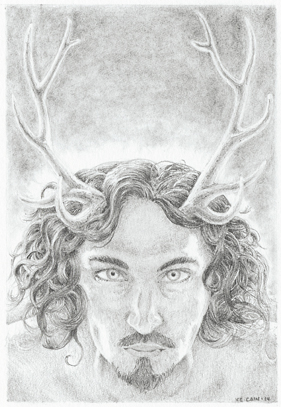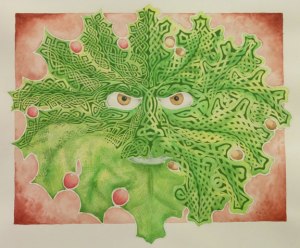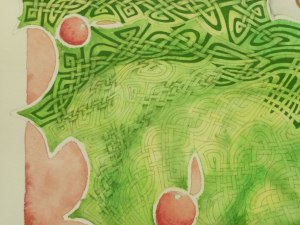As promised, I’m writing about Herne the Hunter today. He is a deity with which I have a close affinity, so naturally I wanted to include him in my portraits of Death Deities. I decided to take another look at some of the information available and the effect it had on my work.
Herne is said to have been a royal hunter in the time of Edward II of England, the early 1300’s. While hunting in the woods around Windsor Castle, Edward was attacked by a stag and Herne threw himself in front of the king. None of Edwards other woodsmen would heal Herne out of jealousy. It was finally a dark rider who agreed to help and cut the horns off the stag and tied them to Herne’s head. He was healed, but lost all his prowess as a hunter. In despair at the loss of his skill, he ran into the forest, wearing the antlers and was later found hanging from an oak tree. When Edward’s retainers tried to recover the body, it had disappeared. The tree is known as Herne’s Oak and is mentioned in Shakespeare’s Merry Wives of Windsor. Since that time, Herne the Hunter has reappeared in the Windsor Great Park many times, most recently in the 1970’s.
What is interesting though is the possibility that the story goes back even further. H and C are interchangeable between the Indo-European languages and therefore Hern can become Cern and applied to Cernunnos, a horned deity depicted on the Gundestrup Cauldron, dated between 200 BC and 300 AD. So here we have a horned deity sharing Herne’s name a thousand years before the reign of Edward II.

Jesus on the Cross, by Albrecht Dürer, Wodin Hanging, by Franz Stassen, and Herne’s Oak, from the Folger Shakespeare Library
So, you may ask, what does this have to do with Death Deities? Well, obviously Herne symbolizes sacrifice. He first put himself in harms way to protect his king, and then hung himself on the oak. (Parallels abound with Odin and Jesus.) After Herne’s disappearance, he was seen as the leader of the Wild Hunt, a spectral phenomenon throughout Northern Europe usually occurring in winter and presaging some sort of disaster. Herne and Cernunnos are seen as the Holly King and Oak King respectively, by modern pagans, and they symbolize the cycle of death and rebirth in nature. If we link Herne with Odin (who was widely revered in Anglo-Saxon Britain) we see a god who escorts the dead to the afterlife. And I’m just skimming over the surface. A great resource is Eric L. Fitch’s book: ‘In Search of Herne the Hunter’. If you’re interested in this mythical figure at all, I highly recommend it.
And finally, we come to the drawing I did for the show. A friend was surprised when she saw how young Herne is. Traditionally he is depicted as an older man, middle aged at least. His beard is long and his hair longer. But in the story of Herne, he is human and eventually becomes the ghostly, horned hunter. So he was young once, maybe even at his death. There is also the fact that this telling of the tale is one of the more recent versions (in a historical context) and therefore younger.
However one chooses to look at it, the image in the drawing is what I saw in my mind’s eye. And perhaps that is how Herne wished to appear. This time.









